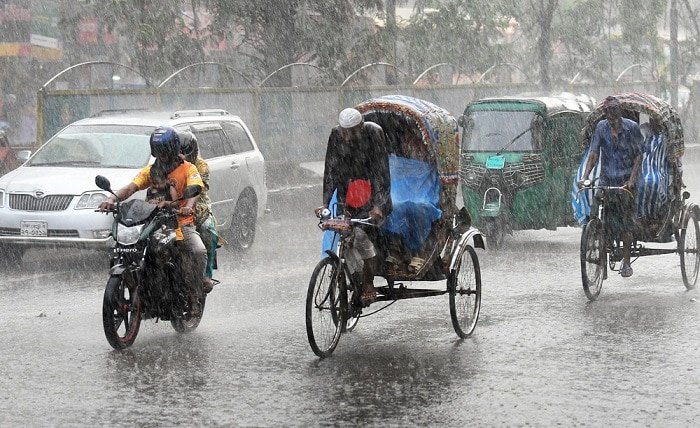আবহাওয়া: Everything You Need to Know About Weather Patterns, Climate Change, and Seasonal Forecasts in Bangladesh

The word আবহাওয়া refers to the atmospheric conditions of a place at a given time. It includes parameters like temperature, humidity, wind speed, and precipitation. In Bangladesh, the আবহাওয়া plays a significant role in agriculture, lifestyle, and economy. Whether you’re a farmer, student, or traveler, understanding the nuances of আবহাওয়া can help in planning your daily activities and long-term goals.
The Science Behind আবহাওয়া
Understanding the science behind আবহাওয়া involves studying meteorology. This branch of science focuses on atmospheric phenomena and their interactions with Earth’s surface. Meteorologists use advanced tools like satellites, weather radars, and computer models to predict আবহাওয়া. These forecasts help warn people about extreme weather events such as cyclones, floods, or heatwaves, which are common in regions like Bangladesh.
How আবহাওয়া Affects Daily Life in Bangladesh
In a country like Bangladesh, where agriculture is a primary occupation, the আবহাওয়া directly impacts the livelihood of millions. Seasonal patterns such as monsoon and dry spells determine the sowing and harvesting cycles. Moreover, people’s clothing, food habits, and even health are influenced by the আবহাওয়া. For instance, in winter, respiratory diseases increase due to cold temperatures and fog, while in summer, people suffer from heat strokes and dehydration.
Seasonal Variation of আবহাওয়া in Bangladesh
The আবহাওয়া in Bangladesh varies significantly across the four main seasons: summer, monsoon, autumn, and winter. During the summer, temperatures can soar above 40°C, especially in the northern and western districts. The monsoon season brings heavy rainfall, which is vital for crops but also causes waterlogging and floods. In winter, temperatures drop, particularly in the northern areas, affecting crop yields and increasing demand for warm clothes.
The Impact of Climate Change on আবহাওয়া
Climate change is having a profound effect on আবহাওয়া globally, and Bangladesh is no exception. Rising sea levels, increasing temperatures, and irregular rainfall patterns are disturbing the ecological balance. The country faces more frequent and severe natural disasters due to unpredictable আবহাওয়া. Adaptation strategies like sustainable agriculture and flood management systems are essential to combat the adverse effects of changing climate patterns.
How Technology is Improving আবহাওয়া Forecasting
With technological advancements, predicting আবহাওয়া has become more accurate and accessible. Bangladesh Meteorological Department (BMD) uses satellite imagery, Doppler radar systems, and AI-based prediction models to inform the public. Apps and SMS services now provide real-time updates about আবহাওয়া, helping farmers, fishermen, and travelers make informed decisions. These innovations are crucial for a disaster-prone country like Bangladesh.
Historical Changes in আবহাওয়া Trends
Over the past few decades, the আবহাওয়া in Bangladesh has shown noticeable changes. Winters are becoming shorter and milder, while summers are growing longer and hotter. Cyclones and heavy rainfall are now more frequent, pointing to a shift in climate trends. These historical changes in আবহাওয়া highlight the urgent need for environmental awareness and sustainable development practices.
Role of Government and NGOs in আবহাওয়া Monitoring
Several organizations, including the government and non-governmental bodies, monitor আবহাওয়া to provide early warning systems and disaster relief. The Ministry of Disaster Management and Relief, along with BMD, plays a vital role in disseminating weather alerts. NGOs work at grassroots levels to train communities on how to respond to abrupt changes in আবহাওয়া. These collaborations are saving lives and minimizing property damage during natural calamities.
The Connection Between আবহাওয়া and Natural Disasters
Bangladesh is highly susceptible to natural disasters like floods, cyclones, and droughts due to its geographical location and volatile আবহাওয়া. These extreme events have devastating impacts on agriculture, housing, and infrastructure. Effective monitoring of আবহাওয়া conditions and timely alerts can significantly reduce the damage caused by such disasters. Community-based disaster preparedness programs have been successful in areas vulnerable to climate shocks.
Agriculture and the Importance of Predicting আবহাওয়া
Farmers rely heavily on accurate predictions of আবহাওয়া to make critical decisions. From planting to irrigation, every agricultural activity depends on the weather. Crop calendars are designed based on the expected seasonal আবহাওয়া, and any deviation can result in loss of yield. Agri-tech companies are now providing hyper-local weather forecasts to ensure better planning and productivity in farming communities.
Urban Life and আবহাওয়া: A Growing Concern
In urban areas, আবহাওয়া influences everything from traffic conditions to air quality. Cities like Dhaka experience urban heat island effects, where temperatures are significantly higher than surrounding rural areas. Pollution levels also vary with changes in আবহাওয়া, affecting respiratory health. Smart city solutions are being explored to monitor and manage urban আবহাওয়া impacts through real-time sensors and AI tools.
Traditional Knowledge Systems and আবহাওয়া
For centuries, local communities in Bangladesh have relied on traditional knowledge to interpret আবহাওয়া. Farmers observe changes in bird behavior, cloud formations, and wind patterns to forecast weather. While not always accurate, these methods show how closely human life is connected to আবহাওয়া. Today, combining traditional wisdom with modern technology offers a holistic approach to weather prediction.
Education and Public Awareness on আবহাওয়া
Educational institutions and media play a key role in raising awareness about আবহাওয়া. From school curriculums to public campaigns, learning about weather systems, climate change, and disaster preparedness is becoming more common. Accurate understanding of আবহাওয়া can reduce panic during storms and help people make safer choices. Mass media broadcasts and social media also disseminate real-time আবহাওয়া alerts efficiently.
Global Comparison of আবহাওয়া Patterns
The আবহাওয়া of Bangladesh shares similarities and differences with other countries in South Asia. While monsoon is common across the region, the intensity and timing differ. Compared to countries like India or Nepal, Bangladesh is more vulnerable due to its low-lying deltaic geography. Studying global weather patterns helps meteorologists understand anomalies and predict future changes in আবহাওয়া more accurately.
Climate Resilience and Adaptation to Changing আবহাওয়া
Building resilience to cope with changing আবহাওয়া is essential for long-term sustainability. Community-based adaptation techniques, such as rainwater harvesting, floating gardens, and cyclone shelters, are proving effective in Bangladesh. These practices empower people to survive and thrive despite unpredictable আবহাওয়া. Resilience also involves education, infrastructure development, and social safety nets for vulnerable populations.
Popular Apps and Platforms for আবহাওয়া Updates
In the digital age, several apps and platforms provide real-time আবহাওয়া information. Popular choices in Bangladesh include AccuWeather, Weather.com, Windy, and the BMD’s own app. These platforms offer forecasts, weather maps, and alerts in both English and Bangla. Access to accurate and timely আবহাওয়া data has made it easier for citizens to prepare for any condition, be it rain or storm.
The Role of Media in Disseminating আবহাওয়া News
Television, radio, and online platforms play a critical role in sharing আবহাওয়া information. From daily weather bulletins to breaking news during disasters, the media ensures that people stay informed. Social media channels like Facebook and YouTube have also become important sources of weather updates. Timely dissemination of আবহাওয়া news can be the difference between safety and danger during emergencies.
How to Read আবহাওয়া Charts and Forecasts
To benefit from আবহাওয়া forecasts, one must understand how to read weather charts. These include symbols for temperature, rainfall, wind direction, and atmospheric pressure. Mobile apps usually simplify this information for easy understanding. By learning to interpret আবহাওয়া charts, anyone can stay ahead of weather changes and plan accordingly—whether it’s scheduling an event or protecting crops.
How Tourism is Affected by আবহাওয়া in Bangladesh
Tourism in Bangladesh is closely linked to আবহাওয়া conditions. Places like Cox’s Bazar and the Sundarbans attract visitors during cooler and dry months, while monsoons can deter tourists due to floods or travel disruptions. Event organizers, hoteliers, and tour operators monitor আবহাওয়া trends to optimize travel schedules and ensure tourist safety. Promoting eco-tourism based on seasonal আবহাওয়া patterns is gaining popularity.
The Future of আবহাওয়া Studies in Bangladesh
With growing challenges posed by climate change, the future of আবহাওয়া studies in Bangladesh looks both demanding and promising. Academic institutions are offering specialized programs in environmental science and meteorology. Investments in research, data collection, and international collaboration are enhancing the country’s capability to predict and manage complex আবহাওয়া patterns. Young professionals are also entering this field, contributing fresh ideas and innovative solutions.
Conclusion
In conclusion, the আবহাওয়া of Bangladesh is more than just a daily weather report—it’s a crucial part of life that affects everything from agriculture to transportation, from health to safety. Understanding, monitoring, and adapting to আবহাওয়া is essential in a country frequently facing natural disasters and climate change. As individuals and communities, staying informed and proactive can help us live better, safer, and more sustainable lives.
FAQs
What does the term “আবহাওয়া” mean?
The term “আবহাওয়া” refers to the atmospheric conditions at a specific time and place, including temperature, rainfall, and wind.
How does আবহাওয়া affect farming in Bangladesh?
Farmers rely on seasonal আবহাওয়া patterns for sowing and harvesting. Any disruption due to irregular weather can lead to crop failure.
Can apps provide accurate আবহাওয়া forecasts?
Yes, apps like AccuWeather and the BMD app offer real-time and reliable আবহাওয়া updates, especially useful in rural and urban areas.
How is climate change impacting Bangladesh’s আবহাওয়া?
Climate change has led to increased temperatures, irregular rainfall, and more frequent disasters, altering traditional আবহাওয়া patterns.
What is the role of the Bangladesh Meteorological Department in আবহাওয়া monitoring?
The BMD monitors, analyzes, and provides forecasts on আবহাওয়া using satellite data and radar to help the public and disaster management agencies.





